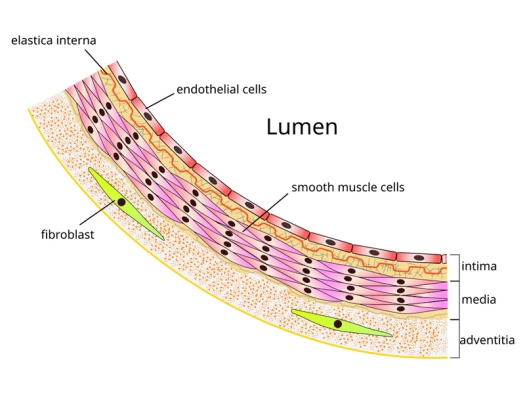MicroscopicAnatomyArtery.jpg

Illustration by Stijn Ghesquiere via Wikimedia Commons / CC BY-SA 4.0
Microscopic anatomy of an artery. The outermost layer is known as tunica adventitia, and is composed of connective tissue made up of collagen fibers. Inside this layer is the tunica media, or media, which is made up of smooth muscle cells and elastic tissue (also called connective tissue proper). The innermost layer, which is in direct contact with the flow of blood, is the tunica intima, commonly called the intima. This layer is mainly made up of endothelial cells. The hollow internal cavity in which the blood flows is called the lumen.M/p>
In a separate article, I reported on two major effects of ozone therapy – decreasing oxidative/free radical stress and improving immune system function. I then explained how these effects played such a big role in eliminating both acute and chronic infections that are resistant to antibiotics. Similarly, in this article, I’m going to report on how adding ozone therapy to established therapies for cardiovascular disease can significantly improve overall results.
Cardiovascular diseases are the leading cause of death and disability. The chief factors leading to cardiovascular diseases are arterial plaque and hypertension. These factors develop from a combination of several mechanisms including inflammation, oxidative stress, immune dysfunction, and infection. As I mentioned last month, all these factors are alleviated by ozone therapy. But these are not the only important factors causing cardiovascular disease that ozone therapy covers.
The most significant factor leading to cardiovascular disease is a breakdown in the function of the inner lining of the arteries called the endothelium. This breakdown is what starts the process leading to the arterial plaque that causes heart disease and strokes. The factors leading to this breakdown are many and include processed plant and seed oils, high blood sugars, air pollution, lead toxicity, vitamin C deficiency, iron excess, tobacco, high blood oxLDL levels, viruses, bacteria, stress, elevated blood homocysteine, PPIs (drugs commonly used for heartburn), dehydration, and NSAID drugs (ibuprofen, etc.). As these factors break down the endothelium, it becomes less able to produce two very important substances critical for circulation and arterial health – hemoxygenase (HO-1) and nitric oxide (NO). And here’s the thing. Both experimental and clinical data show that ozone therapy in addition to its anti-inflammatory, anti-oxidative stress, immune enhancement, and infection eradication effects also upregulates both HO-1 and NO production.
Hemoxygenase (HO)-1 is anti-inflammatory and angiogenic. Inflammation acts to increase plaque formation and decrease blood flow. HO-1 counteracts that. Angiogenic means HO-1 increases the production of new blood vessels in areas that are not getting enough blood flow due to excessive arterial plaque. This is an incredibly important way that the body uses to prevent heart attacks, and show just how critical HO-1 is in heart disease. One review article provides a comprehensive overview of the biochemistry, physiology, and pathophysiology of HO-1 in relation to cardiovascular disease. The authors of that review state: “Furthermore, we present some of the emerging evidence in support of the view that the induction of the HO-1 gene may be a new opportunity to target the pathophysiology of cardiovascular disease with therapeutic implications for management.” Hang on to that thought.
In the last issue, I explained how critical the gene Nrf2 is for reducing inflammation and oxidant/free radical stress. I also explained how ozone therapy is a potent stimulant of Nrf2 activation. What I did not tell you was that Nrf2 also stimulates the production of HO-1. Since ozone stimulates Nrf2, it would be expected that it would also activate HO-1. To see if that’s what happens, Professor Velio Bocci and his team infused ozone into blood and then exposed endothelial cells to the ozonated blood. They found that the ozone-treated blood did in fact stimulate the endothelial cells to produce increasing amounts of HO-1. And the more the blood was ozonated, the greater the production of HO-1. The researchers concluded that ozonating the blood of patients with cardiovascular disease can significantly benefit patients being treated with established cardiovascular therapies.
In a similar series of experiments, researchers discovered that blood treated with ozone also induced the endothelial cells to produce and release NO. As you already know, the NO produced by the endothelial cells is what opens up arteries and capillaries and increases blood flow. The way the medication nitroglycerin works to prevent heart attacks is by increasing NO production. When the researchers exposed endothelial cells to blood treated with ozone, they found a “significant and steady increase of NO production.” Just like HO-1, the more the blood was ozonated, the greater the production of NO. They concluded that “It appears that reinfusion of ozonated blood, by enhancing release of NO, may induce vasodilation in ischemic areas and reduce hypoxia.” What they are saying is by ozone inducing the production of NO, it acts to heal the very areas in the heart and the brain that don’t get enough blood flow from heart attacks and strokes.”
A recent 2020 review paper looked at the published effects of ozone therapy on peripheral artery disease risk factors, symptoms, as well as on quality of life. Peripheral artery disease is where the smaller blood vessels are constricted and clogged off leading to a dangerous decrease in blood flow. The authors of the review reported that ozone therapy not only improved circulation by stimulating HO-1 and NO production, it also acted to decrease the way platelets stick together to form blood clots, which is another way to improve circulation. By the way, preventing platelets from sticking together is exactly what some of the drugs do that cardiologists routinely rely on. They also reported that ozone therapy improved mitochondrial structure and healed the cells damaged by peripheral artery disease. They concluded that “It [ozone therapy] appears to be an effective adjunctive therapy [added to established therapies] in preventing peripheral artery disease complications such as the occurrence of a cardiovascular event, amputation or other extreme surgical solutions.”
Valdes and his team reported on fifteen patients with atherosclerosis obliterans of their leg arteries. This is a condition in which arterial plaque has grown to the extent that it is almost completely blocking off all blood flow. Normally, this condition is treated with bypass surgery, but these patients were so diseased that they were not candidates for surgery. So instead of surgery, the researchers treated some of the patients with ozone therapy. Those patients had 50% fewer amputations and 50% fewer pain complications than the patients not getting ozone therapy. They concluded that because of the dramatic reduction in amputation rates and decreased need for surgical pain procedures, ozone therapy was effective for this serious disease.
Maslennikov and his group treated the blood of 81 men and women with atherosclerosis of various artery vessels leading to decreased blood flow. They reported that all of the patients improved due to decreased platelet-induced blood clotting, a decrease in fibrinogen concentration leading to less plaque production, an increase in the action of fibrinolytic enzymes that dissolve clots, and improved overall blood flow.
So, in conclusion, ozone therapy hits all the factors that lead to cardiovascular disease: Oxidative stress is reduced by activating Nrf2; the infections that cause plaque are eliminated by cytokine stimulation; the clotting that leads to plaque formation is decreased; HO-1 is increased leading to decreased inflammation and increased circulation and new blood vessel growth (angiogenesis); nitric oxide is increased leading to increased circulation and restoration of the endothelium.
And here’s the point. None of these underlying factors of cardiovascular disease are addressed with established therapies, such as medications, stents, and bypass surgeries. So, if you have a history of cardiovascular disease or are currently undergoing treatment for it, make sure to consult with a practitioner who is familiar with ozone therapy. It is the perfect partner for established therapies.
References
Frak W, Wojtasinska, et al. Pathophysiology of Cardiovascular Diseases: New Insights into Molecular Mechanisms of Atherosclerosis, Arterial Hypertension, and Coronary Artery. Biomedicines. Disease2022 Aug; 10(8): 1938.
Idriss NK, Blann AD, et al. Hemoxygenase-1 in cardiovascular disease J Am Coll Cardiol. 2008 Sep 16;52(12):971-8.
Pecorelli A, Bocci V, et al. NRF2 activation is involved in ozonated human serum upregulation of HO-1 in endothelial cells. Toxicol Appl Pharmacol. 2013 Feb 15;267(1):30-40.
Valacchi G, Bocci V. Studies on the biological effects of ozone: 11. Release of factors from human endothelial cells Mediators Inflamm. 2000;9(6):271-6.
Juchniewicz H, Lubkowska A. Oxygen-Ozone (O2-O3) Therapy in Peripheral Arterial Disease (PAD): A Review Study. Ther Clin Risk Manag. 2020 Jun 29:16:579-594.
Valdes AR, Cwepero SM, et al. Ozone therapy in the advanced stages of arteriosclerosis obliterans. Angiologia. 1993 Jul-Aug;45(4):146-8.
Maslennikov OV, Sharov IG, et al. Effect of ozone therapy on hemostatic changes in patients with vascular atherosclerosis. Klin Med (Mosk). 1997;75(10):35-7.
Why Heart Patients Need Ozone Therapy was originally published in Dr. Frank Shallenberger’s Second Opinion newsletter, May 2024. Used with permission.


